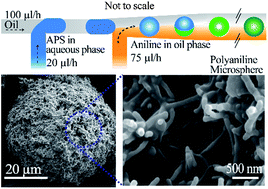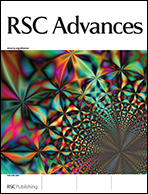Fabrication of conducting polyaniline microspheres using droplet microfluidics†
Abstract
Polyaniline (PANI) is a conducting polymer with very diverse applications in the areas of sensing, bioelectronics, biofuels, toxic metal recovery and rechargeable batteries. In this work, monodispersed PANI microspheres in the semi-conducting range are facilely synthesized via chemical oxidation by using droplet microfluidics. These PANI microspheres are characterized by scanning electron microscopy (SEM), energy-dispersive X-ray spectroscopy (EDX), UV-visible spectroscopy and conductivity measurements with three different molar concentrations of the polymer. The effect of the molar ratio of ammonium persulfate to aniline on the morphology, chemical structure and conductivity of the PANI microspheres is investigated. The conductivity of the PANI microspheres is on the order of 10−3 S cm−1 by using our microfluidic platform, comparable to that of the existing PANI nanostructures. In comparison with the existing self-assembly or template methods for PANI synthesis, our droplet microfluidics based procedure provides an inexpensive, rapid, and higher throughput one-step synthesis route for the fabrication of PANI microspheres with controlled size, functionality and biomolecule encapsulation capacity for biosensing and controlled drug release applications.


 Please wait while we load your content...
Please wait while we load your content...